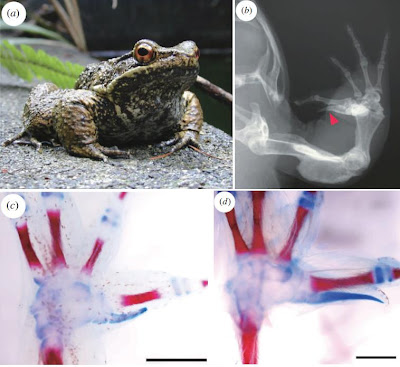Frogs have highly conserved hand and foot morphology, possessing four fingers and five toes. As an exception, two Japanese ranid frog species, the Otton frog Babina subaspera and the dagger frog Babina holsti, possess a unique thumb-like structure (the pseudothumb) in the forelimb,giving an appearance of a total of five fingers on the hand. To obtain insights into the developmental mechanisms that generate this novel character, we investigated the hand morphogenesis of the Otton frog. The unique morphological pattern of the pseudothumb was already established in juveniles. Surprisingly, the bud-like structure, which is similar to the area of inductive activity (e.g. feather buds in birds and the carapacial ridge in turtles), was detected over the site where the future prepollex develops in larvae. By contrast, this bud-like structure was not found in larvae of other ranid species. We discuss possible scenarios that would favour the evolution of this very unusual trait in frogs.
Keywords: Anura; limb morphogenesis; morphological novelty; prepollex; Ranidae
Tokita, M. & Iwai, N. 2010. Development of the pseudothumb in frogs. Biol. Lett. 6, 517–520. http://rsbl.royalsocietypublishing.org/content/6/4/517
